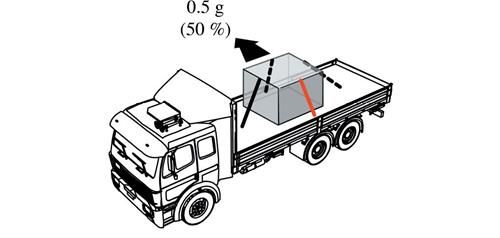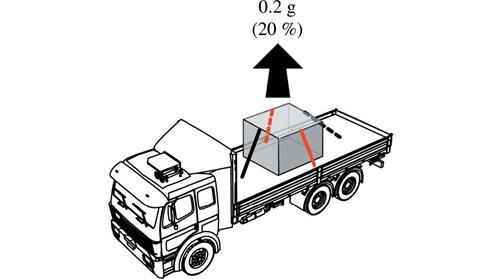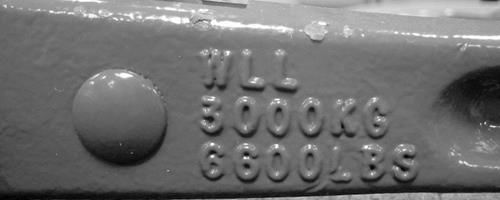Review Questions - Click On The Picture To Begin...

- 100% of cargo weight.
- 50% of cargo weight.
- 20% of cargo weight.
- 0
Quote From The CDL Manual:
Note: Friction mats, which are not marked by the manufacturer, are assumed to provide a resistance to horizontal movement equal to 50% of the cargo weight that is resting on the mat.
- 2,500 lbs
- 5,000 lbs
- 6,000 lbs
- 10,000 lbs
Quote From The CDL Manual:
Note: The minimum WLL requirement for the securement system is 50%. More tiedown capacity should be used if you need to secure an article against any movement.
- A structure, device, or another substantial article placed against an article to prevent it from tipping that may also prevent it from shifting.
- A vertical barrier placed directly behind the cab of a tractor to protect the cab in the event cargo should shift forward.
- A device placed on the exposed edge of an article to distribute tiedown forces over a larger area of cargo than the tiedown itself, to protect the tie-down and/or cargo from damage, and to allow the tiedown to slide freely when being tensioned.
- A rail along the side of a vehicle that protects the side of the vehicle from impacts.
Quote From The CDL Manual:
Edge protector:
A device placed on the exposed edge of an article to distribute tiedown forces over a larger area of cargo than the tiedown itself, to protect the tie-down and/or cargo from damage, and to allow the tiedown to slide freely when being tensioned.
- All of these are true.
- The WLL is usually assigned by the component manufacturer.
- The Working Load Limit is the maximum load that may be applied to a component of a cargo securement system.
- The minimum WLL requirement for the securement system is 25%.
Quote From The CDL Manual:
The Working Load Limit is the maximum load that may be applied to a component of a cargo securement system during normal service.
The WLL is usually assigned by the component manufacturer.
Note: The minimum WLL requirement for the securement system is 50%. More tiedown capacity should be used if you need to secure an article against any movement.
- Between 45 and 60 degrees.
- 90 degrees.
- Less than 45 degrees.
- It doesn't matter.
Quote From The CDL Manual:
The angle where the tiedown attaches to the vehicle should be shallow, not deep (ideally less than 45).
- A specialized container, primarily used to contain and transport materials in the waste, recycling, construction/demolition, and scrap industries, which are used in conjunction with specialized vehicles, in which the container isloaded and unloaded onto a tilt frame body by an articulating hook-arm.
- A reusable, transportable enclosure that is especially designed with integral locking devices that secure it to a container chassis trailer to facilitate the efficient and bulk shipping and transfer of goods by, or between various modes of transport, such as highway, rail, sea, and air.
- A platform or tray on which cargo is placed so that it can be handled as an article. (Same as "Skid")
- A vehicle especially built and fitted with locking devices for transport.
Quote From The CDL Manual:
Intermodal Container:
A reusable, transportable enclosure that is especially designed with integral locking devices that secure it to a container chassis trailer to facilitate the efficient and bulk shipping and transfer of goods by, or between various modes of transport, such as highway, rail, sea, and air.
- 100% of cargo weight.
- 50% of cargo weight.
- 20% of cargo weight.
- 80% of cargo weight.
Quote From The CDL Manual:
Note: The minimum WLL requirement for the securement system is 50%. More tiedown capacity should be used if you need to secure an article against any movement.
- Bulkhead
- Void filler
- Cleat
- Stake pocket
Quote From The CDL Manual:
Stake Pocket:
A female housing fixed to the side or ends of a vehicle to receive a stake or peg, and may also be used as an anchor point.
- Use some kind of blocking.
- Put something heavy on top of the cargo.
- Attach tiedowns to the cargo.
- Set the cargo on friction mats.
Quote From The CDL Manual:
What should you use in low-friction situations?
When there is low friction between the cargo and the deck (for example, with snow, ice, sand, gravel, and oil):
- Use tiedowns attached to the cargo.
- Use a means to improve the friction such as friction mats or tiedown that pass over the cargo.
- Use blocking and tiedowns.






 Related Cargo Securement Terms That Every Driver Should Know:
Related Cargo Securement Terms That Every Driver Should Know: 



 TT On Facebook
TT On Facebook